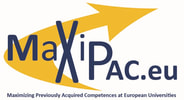About the project
The overall goal of the project is for third-country nationals, such as refugees, to have optimal opportunities in European higher education.
According to the Bologna Declaration (1999) universities and universities of applied sciences have the autonomy to valorise the qualifications (degrees) and competences acquired elsewhere according to their own standards. It is part of the Lisbon Recognition Convention (1997), which aims to valorise qualifications obtained in higher education. The Lisbon Recognition Convention says that all countries should develop procedures to assess whether refugees and displaced persons fulfill the relevant requirements for access to higher education or to employment activities, even in cases in which the qualifications cannot be proven through documentary evidence. To this day, this directive has to a large extent remained a dead letter.
MaxiPAC.EU wants to fill this gap.
Each university or university of applied sciences has the autonomy to organise the inflow of third country nationals and to decide on the program of this group of lateral entrants. Any structure in terms of recognition of qualifications and competences acquired elsewhere is lacking for third country nationals who wish to continue their studies in Europe after they have already made their way into higher education outside Europe. It is clear that there is no proper tool to enable universities and universities of applied sciences to effectively scale up the qualifications and competences of third country nationals. MaxiPAC.EU wants to develop such a tool or procedure. We now see great differences in approach between the different higher education institutions in different European countries, but also between universities in the same country and even within the same
educational institution.
We strive for an inclusive society, where third-country nationals are able to participate in higher education. The long term result will be a proportional representation of all segments of society within higher education.
There are two target groups:
1. The universities and universities of applied sciences. The project will deliver a uniform, accessible procedure for all refugees and third country nationals at European universities.
2. Refugees and third country nationals. A standard procedure to measure and valorise their compentences acquired elsewhere, will increase their access through lateral entrance in higher education institutions in the European Union.
To achieve the project goal, an assessment procedure for refugees on higher education campuses in Finland (Seinäjoki University of Applied Sciences (SeAMK)), Belgium (Thomas More), Italy (University of Bari) and Greece (Harokopio University) will be developed, together with the European student organisation AEGEE. Because AEGEE has numerous student members from outside the EU, this target group is also directly involved in the development of our outputs.
Project methodology envisaged will provide three complementary types of meeting: 'transnational project meetings'; 'national monitoring committees' in all four participating countries; an 'advisory board'. A source of intellectual enrichment comes from the geographical spread of all mentioned organizations so far, not limited to the four partner countries. Nine associated partners across Europe support the project and will help ensure its dissemination. There are already 14 universities in Europe that have agreed to spread the project results within their own university and beyond. A risk assessment matrix is already started at the moment of redaction of the project charter, and will be continued throughout the project.
We will generate 5 outputs of which output 1 - namely the development of a uniform procedure to valorise previously acquired competences of third-country nationals by universities - is the most important. This output will be finally delivered at the end of the project and requires the input of all other outputs that deal with modalities and organizational and implementation aspects, languages and e-learning. Each outcome is linked to an event. We also provide two training sessions: one in the first year of the project with an overview of what has already been developed in Europe on this subject and a second with a training of the procedure in the last year of the project.
Progression on delivery of these outputs will continuously be communicated via the MaxiPAC.EU website (http://www.maxipac.eu). This channel will be used to communicate the project results and is open for information requests of all kinds related to the project.





